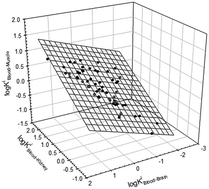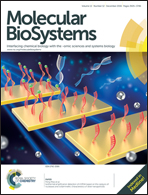Analysis of the distribution of organic compounds and drugs between biological tissues in the framework of solute partitioning in aqueous two-phase systems†
Abstract
Partition coefficients of non-ionic essentially nonpolar compounds between air and rat biological tissues and between blood and other tissues were examined and found to be linearly interrelated according to the previously established equation for partition coefficients of solutes in aqueous two-phase systems: log Kblood–tissue-1 = k0 + k1 log Kblood–tissue-2 + k2 log Kblood–tissue-3, where k0, k1, and k2 are constants. Analysis of partition coefficients of amphiphilic and ionizable drugs between blood and different tissues in rats in vivo showed that the above relationship holds for the blood–tissue partition coefficients of these compounds as well. The data obtained indicate that distribution of organic compounds between different biological tissues may be considered in the framework of solute partitioning in aqueous two-phase systems, and imply that aqueous media in different tissues have different solvent properties, and compound–water interactions in these media may respond to different environments governed by the tissue composition.


 Please wait while we load your content...
Please wait while we load your content...